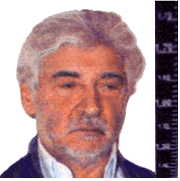...Best of Sicily presents... Best of Sicily Magazine. ... Dedicated to Sicilian art, culture, history, people, places and all things Sicilian. |
by Maria Luisa Romano | ||
Magazine Index Best of Sicily Arts & Culture Fashion Food & Wine History & Society About Us Travel Faqs Contact Map of Sicily
|
Lo Piccolo father and son were on Italy's "30 Most Wanted" list. Like Totò Riina and son, they can look forwarded to extended prison sentences. In truth, Salvatore Lo Piccolo may not have been the supreme head of the Sicilian Mafia so much as a kind of "regional administrator" of its western Sicilian district and perhaps an acting substitute for the incarcerated Provenzano, so "decapitation" is perhaps an overzealous description of his arrest. If the protection racket is far from defeated, it has at least been dealt a serious blow --perhaps the most powerful in decades. For now, the Lo Piccolos refuse to speak to interrogators; that is their right under Italian law, and their attorney says they will respond to questions only in court. That day will come (at the earliest) late in 2008. There is no urgency, as both can expect to remain in prison for many decades to come. When apprehended, Mr. Lo Piccolo had in his possession numerous scribbled notes to "punish" around thirty local business owners who belonged to Palermo's Addio Pizzo and so refused to pay for his organisation's "protection." According to the Giornale di Sicilia and La Repubblica (9 November 2007), this included some major local businesses. In fact, the phenomenon is quite prevalent; according to some estimates 65% of the shops in the city's prestigious Via Libertà pay the pizzo. As many as 20% may be involved more in money laundering than in selling anything, and even phantom schools exist to obtain public funding. The problem doesn't end there, for political corruption (assigning public contracts for construction projects and various "outsourced" services based on pay-offs made to politicians to steer them toward certain firms) is almost as dirty as the pizzo. More recently, on 3 December, Daniele Emanuello, the Mafia "boss" of Gela, was shot dead by police as he fled arrest; he was surrounded and actually tried to jump out a window. This is, in itself, unusual, as Mafiosi rarely literally run or attempt suicide in the face of capture --though many police would welcome a shoot-out which might bring immediate justice to criminals who rarely end up facing severe sentences. An article in The Economist ("A Declining Family Business," Dec 8-14 2007, p 38) puts the annual estimated value of the pizzo in Sicily at 8 billion euros (US $12 billion). Incredibly, even hospitals and the University of Palermo (itself a highly corrupt institution) have been approached for pizzo payments. Mr. Emanuello died with a bunch of notes in his mouth (he was attempting to swallow them) implicating others. This led, in late December 2007, to the arrest of the owner of a chain of large supermarkets in western Sicily whose business is believed to be a front for Matteo Messina Denaro, a mafioso in hiding for over a decade who is thought to reside someplace in Sicily. To what degree have such practices crippled the Sicilian economy? Considerably, but they are only part of a general pattern in a society where recommendations (preferments) are necessary to obtain jobs in schools and banks, and where even the universities are incurably corrupt with clientilism and poorly administered. Numerous public "projects" are equally corrupt, and it has been plausibly suggested that political parties still buy votes in Sicily during major elections. The health-care system is plagued by equally absurd problems, and the infamous "Rape of Palermo" was no accident. The real reason the Mafia still exists as a powerful force in Sicilian life is because it is part of a general way of thinking. Social activist Danilo Dolci and judges Giovanni Falcone and Paolo Borsellino were only the most publicly vocal proponents of the idea that for the Mafia to be erased from Sicilian society, or at least marginalised to the point of insignificance, fundamental attitudes must change first. Organisations such as Addio Pizzo, to the extent that they survive frontal assaults by the Mafia and (much worse) public skepticism in general, are but a single --if essential-- first step toward social change. Any alternative dooms Sicily to a bleak future as a socially under-developed backwater of Europe. About the Author: Maria Luisa Romano has written for various Italian magazines, including this one. | |
Top of Page |
 In early November,
when
In early November,
when